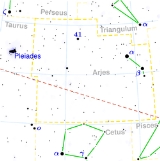
Nakshatra
Overview
Nakshatra also called Nagari , is an abugida alphabet of India and Nepal...
: नक्षत्र ) is the term for lunar mansion
Lunar mansion
A lunar mansion is a segment of the ecliptic through which the moon moves in its orbit around the earth, often used by ancient cultures as part of their calendar system...
in Hindu astrology. A nakshatra is one of 27 (sometimes also 28) sectors along the ecliptic. Their names are related to the most prominent asterisms
Asterism (astronomy)
In astronomy, an asterism is a pattern of stars recognized on Earth's night sky. It may form part of an official constellation, or be composed of stars from more than one. Like constellations, asterisms are in most cases composed of stars which, while they are visible in the same general direction,...
in the respective sectors.
The starting point for the nakshatras is the point on the ecliptic directly opposite to the star Spica
Spica
Spica is the brightest star in the constellation Virgo, and the 15th brightest star in the nighttime sky. It is 260 light years distant from Earth...
called Chitrā in Sanskrit
Sanskrit
Sanskrit , is a historical Indo-Aryan language and the primary liturgical language of Hinduism, Jainism and Buddhism.Buddhism: besides Pali, see Buddhist Hybrid Sanskrit Today, it is listed as one of the 22 scheduled languages of India and is an official language of the state of Uttarakhand...
(other slightly different definitions exist).
Unanswered Questions
Discussions

